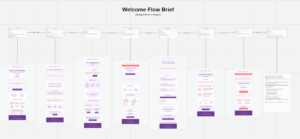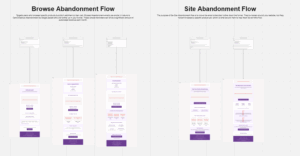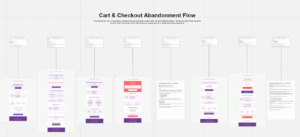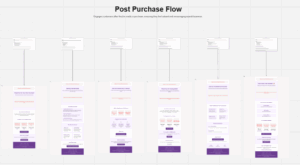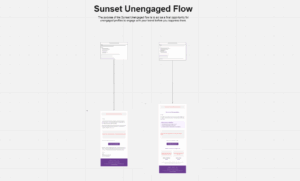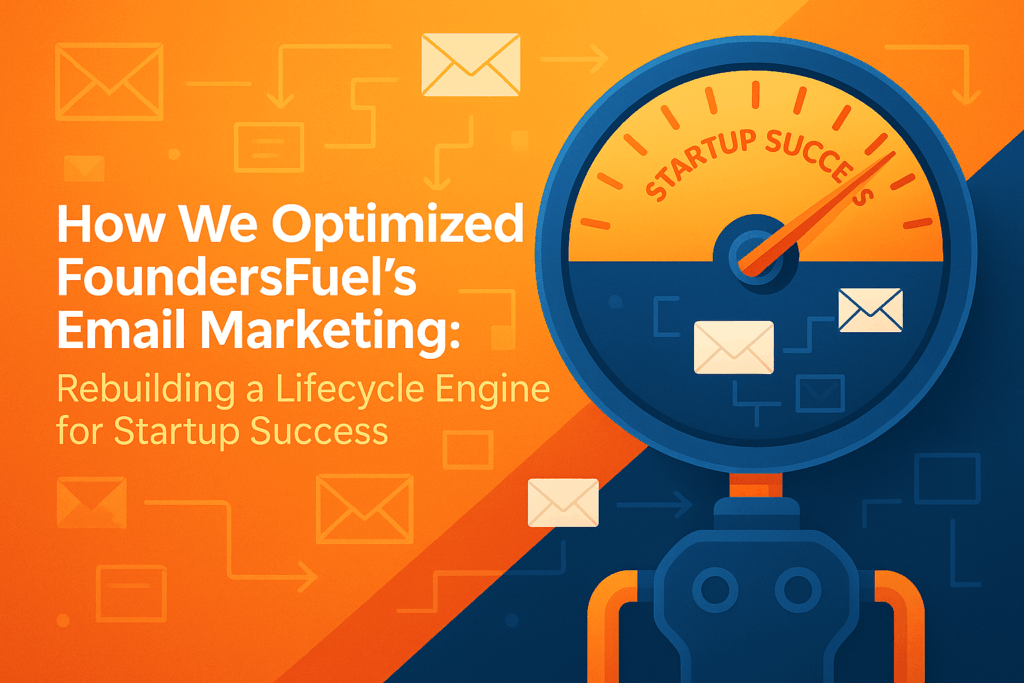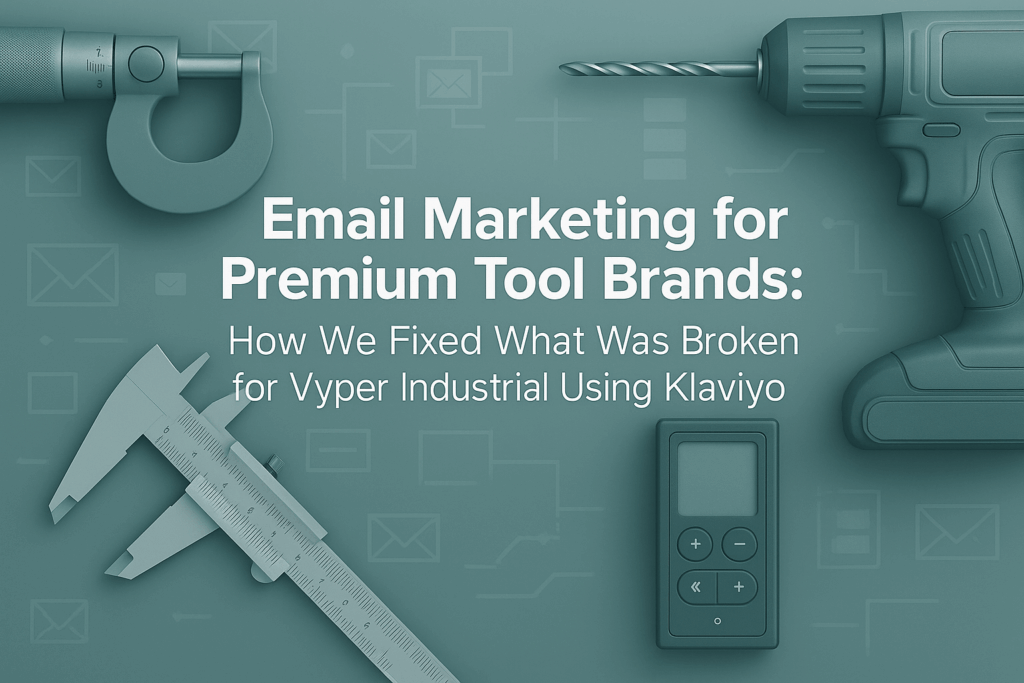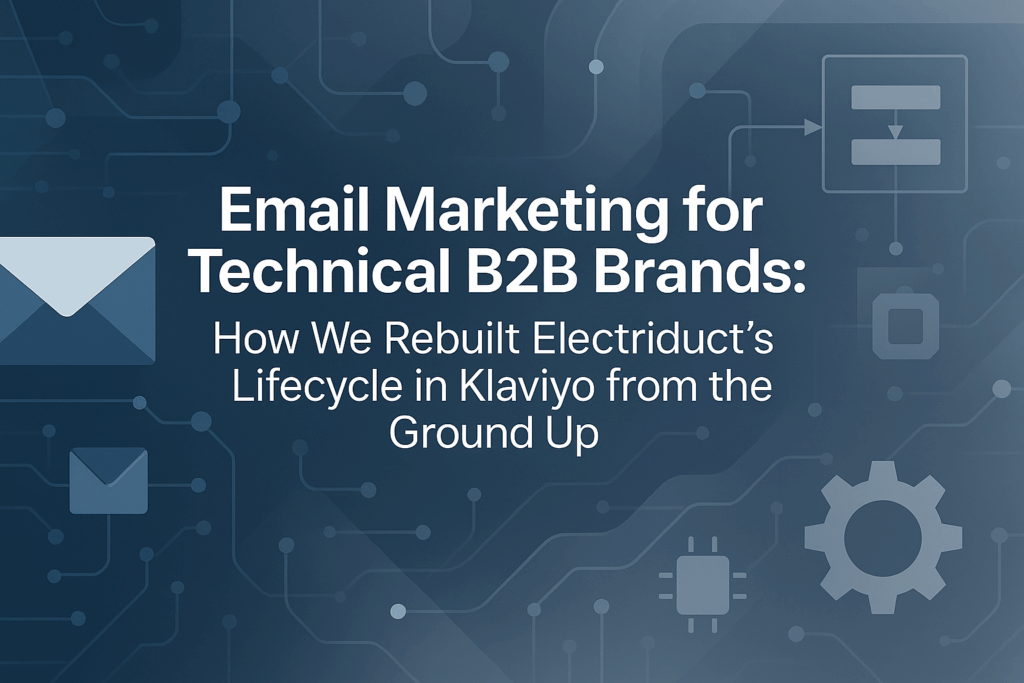When you think of elite fuel delivery systems in the racing world, Aeromotive Inc. is one of the first names that comes to mind. Their founder, Steve Matusek, brought a background in aerospace and turned it into a legacy of performance for the automotive world — with fuel components trusted in 3,000+ horsepower builds and weekend garage projects alike.
But while their products set the bar for engineering precision, their email marketing wasn’t firing on all cylinders.
Like many specialty brands that prioritize technical innovation, Aeromotive had underinvested in lifecycle communication. Their emails weren’t connecting with customers after purchase. First-time buyers were slipping through the cracks. And high cart abandonment rates were signaling missed opportunities to educate and convert — especially with complex systems that demand technical confidence.
When Aeromotive brought us in, the goal wasn’t just to build email flows. It was to build a system that matched their reputation: smart, sharp, mechanically sound — and tuned for performance.
We weren’t creating newsletters. We were engineering a communication engine. Something that could nurture trust, speak fluently to horsepower-obsessed buyers, and recover revenue that was being left on the table.
Here’s how we approached the rebuild:
- We mapped out a strategy built around 7 lifecycle email flows, totaling 34 distinct emails
- We translated technical expertise into sharp, confident copy that met enthusiasts where they were — in the weeds
- We used segmentation and vehicle fitment data to make emails feel targeted, not generic
- And we designed every email to feel like it came from the same team that built the A1000 pump — all performance, no fluff
This case study breaks it all down — the welcome sequence, the abandonment logic, the cart recovery experience, and everything that came after. If you’re a brand selling complex, high-consideration products in a niche vertical, this is your blueprint.
Challenge: Addressing Hesitation with Education
For most ecommerce brands, abandonment flows are where the sales pressure kicks in.
But for Aeroflow? That wouldn’t work. This isn’t cart urgency or “don’t miss out” hype. It’s moms comparing options, checking insurance, or just getting distracted while holding a baby.
So instead of pushing, we leaned into reassurance and education. We wrote every abandonment email with one goal in mind: help her feel more confident in taking the next step.
Welcome Flow Optimization
For a brand like Aeromotive, the welcome flow couldn’t feel like boilerplate. Their customer base is deeply technical — builders, tuners, racers — people who don’t just want a promo code; they want to know they’re buying from engineers who speak their language.
Our audit of the original welcome emails showed a missed opportunity. The tone was generic. There was no real story. And for a company whose founder built fuel systems from aerospace-grade standards, that absence mattered. The product was premium. The first touchpoint didn’t reflect it.
So, we rebuilt the entire sequence from scratch — 8 emails designed to welcome enthusiasts into a community of serious performance, not just a product catalog.
The 8-Email Welcome Sequence
Each email in this series had a specific role: build credibility, deliver value, and guide buyers closer to the system they need. No fluff, no gimmicks.
1. Introduction + Heritage
We send this email instantly. First impressions count. This email introduces Aeromotive as a performance-first brand with aerospace roots, explaining how Steve Matusek took his knowledge from one precision-driven industry and poured it into another. No coupon codes. Just a clear positioning: we build systems that never compromise.
2. Engineering Story
The second email went deeper into brand legacy. We featured early product milestones — the Fuel Rail Mount Regulator, the A1000 pump — and framed them as game-changers. It was less about nostalgia and more about proof: Aeromotive has always been ahead of the curve.
3. System Overview + Setup Logic
Here, we started educating. We broke down the system architecture — how pumps, regulators, filters, and fittings work together. We explained the difference between EFI and carbureted setups. And we visualized common installation pitfalls. The takeaway: Aeromotive doesn’t just sell parts — we help you build smarter, safer, more reliable systems.
4. Avoiding the 7 Common Mistakes
This one was pure tactical value. We listed the “Seven Deadly Sins” of fuel system design — from undersized filters to poorly grounded pumps — and showed how Aeromotive components were engineered to eliminate them. It read like a tech bulletin but was designed like a lead conversion asset.
5. Product Category Deep Dive
Now that we’d built trust, we highlighted core product families — the A1000 In-Line Pump, adjustable regulators, and the line of high-flow filters. Specs were front and center. Each product was framed not just as a standalone, but as part of an ecosystem.
6. Social Proof + Racers Who Use Us
Real-world validation. We featured customer stories and pro drivers who’ve used Aeromotive gear on and off the track. It added credibility, sure — but more importantly, it showed that this brand isn’t just for race teams. It’s for anyone who builds with intention.
7. Resources + Technical Support
We pointed readers to Aeromotive’s blog, their installation PDFs, and their YouTube tutorials. Everything a builder might need before making a purchase — right there in the inbox. The tone here was, “We’ve got your back,” not “Buy now.”
8. Founder’s Note + Soft Offer
The final email in the series was a direct note from Steve Matusek. No aggressive CTA. Just an authentic “thank you for joining us” with a limited-time offer framed as an appreciation, not a markdown. That nuance kept the premium brand feel intact.
The welcome flow did what a great email system should do: meet people where they are, speak their language, and position the brand as a trusted advisor — not just a product vendor.
Abandonment Flows Optimization
Aeromotive doesn’t make impulse-buy products — their parts are precision-engineered, premium-priced, and performance-critical. So when someone walks away mid-browse or mid-cart, it’s not because they weren’t interested. It’s usually because they had unanswered technical questions, installation doubts, or needed more time to justify the investment.
Instead of pushing discounts or urgency tricks (which don’t match the Aeromotive ethos), we built abandonment flows that respected the customer’s decision-making process and met them with technical clarity.
We split our strategy into two core tracks:
- Site Abandonment → for early-stage researchers
- Browse Abandonment → for shoppers considering specific SKUs
Site Abandonment Flow: Nudging the Researcher
These were folks who visited the site, clicked around categories, but never landed on a specific product. Our job here wasn’t to close — it was to spark curiosity and offer value.
1. “Building a Championship-Worthy Fuel System”
Triggered 24 hours after site visit, this email introduced Aeromotive’s point of view on system design. We used it as a primer — touching on key differences between return-style vs. returnless systems, and linking to a horsepower-to-flow rate calculator. The tone: helpful, not pushy.
2. “Your Performance Questions, Answered”
Three days later, we followed up with a simple but effective Q&A format. Real questions from real customers: “Can I run E85 with the A1000?” “How do I prevent vapor lock on a street/strip car?” Every answer linked to the relevant product category. We weren’t trying to sell — we were showing we knew our stuff.
Browse Abandonment Flow: Supporting the Considerer
This flow triggered when someone viewed a specific product page but didn’t take the next step. Our approach: deliver the missing information that likely kept them from committing.
1. “More Technical Data on the You Viewed”
Sent 24 hours post-visit, this email was all about specs and performance charts. If someone viewed the Eliminator pump, they’d get a breakdown of flow rates by voltage, compatible fittings, and ideal regulator pairings. No pressure. Just clarity.
2. “Complete Your System, The Right Way”
48 hours later, we surfaced complementary components with clear reasons why they matter. Looked at a fuel pump? Here’s the filter you’ll need. Viewed a regulator? Here’s a compatible pump + return line kit. Think of it like guided system building — not upselling.
3. “Pro Tips for Seamless Installation”
Three days later, we tackled what we knew many users worried about: install headaches. So we shared installation photos, bracket options, and troubleshooting videos. We wanted them to feel confident they could handle the install — even if it was their first time using AN fittings.
Visual & Messaging Direction
These flows leaned into Aeromotive’s engineering DNA:
- CAD-style product renders
- Flow charts and cutaway diagrams
- Screenshots from the tech blog and video tutorials
And the copy avoided “marketing voice” entirely. It was written by people who’ve held a wrench and tuned fuel pressure. That mattered.
Cart & Checkout Flow Optimization
Cart abandonment is where so many high-consideration brands lose the thread — and in Aeromotive’s case, it was costing real money. These aren’t impulse buys; these are $300–$800+ components. That means every hesitation (technical uncertainty, install concerns, spec mismatch) matters.
The brand had a basic two-email cart reminder. Generic, soft, and not engineered for the audience.
We replaced it with a purpose-built 8-email sequence focused on removing doubt, verifying compatibility, and helping customers confidently finish what they started.
No fake urgency. No gimmicks. Just authoritative guidance — the same way their engineering team would walk someone through a build sheet.
The 8-Email Cart Flow: Built to Convert with Confidence
1: “Your Fuel System Parts Are Waiting”
Sent just two hours after cart abandonment, this email served as a clean, branded reminder. It included full specs on what was in the cart, a direct “Complete Checkout” CTA, and subtle trust builders like “Used by NHRA Champs” and “Built with Aerospace Precision.”
2: “Let’s Confirm Fitment – Tell Us What You’re Building”
Delivered 24 hours later, this email tackled the #1 reason people pause on high-dollar parts: “Will this even work with my setup?”
We included a dynamic link to a 2-minute fitment questionnaire — horsepower, fuel type, engine platform — that routed directly to Aeromotive’s tech team for quick review.
It doubled as list enrichment and trust-building. When you show you care about getting it right, people relax.
3: “You Might Be Missing a Critical Piece”
At the 48-hour mark, we scanned cart contents and surfaced potential gaps — like filters, regulators, or fittings — based on what the customer had already selected.
For instance, someone with a pump in-cart but no pre-filter would see a visual explanation of how that affects flow rate, alongside a pressure drop chart and targeted suggestions.
It wasn’t upselling. It was engineering oversight prevention.
4: “No Shop? No Problem.”
Three days into the sequence, this one spoke to the garage DIYer. The focus? Install readiness.
We included step-by-step guides, a tools checklist, common mistake warnings, and YouTube walkthroughs showing real-world installs.
This email didn’t just sell confidence — it handed them a playbook.
5: “Performance Is an Investment — Here’s Why It Pays Off”
Five days post-abandonment, we tackled price hesitation directly.
This email told the story of failed fuel delivery setups ruining race weekends — and how getting it right the first time saves money, time, and reliability headaches.
Customer quotes grounded the message in real experience. The price wasn’t positioned as high — it was positioned as wise.
6: “We Answered Your Questions Before You Asked”
A week after the cart was abandoned, we delivered a detailed, product-specific FAQ.
Topics included:
- Ideal fuel pressures
- E85 compatibility
- Safe voltage range
- Noise levels
Rather than sales copy, it read like a well-crafted tech sheet — exactly what Aeromotive’s audience values most.
7: “Manufacturing Schedule Update”
On day 10, we introduced light urgency — but with honesty.
This email explained Aeromotive’s lean production model: limited runs, batch precision, and the risk of missing the current manufacturing cycle if you wait too long.
No tricks. Just transparency — and customers appreciated it.
8: “Still Have Questions? Talk to the Team.”
Two weeks after abandonment, we closed the sequence with an open door. The final nudge. No pressure, no offer — just an invitation to hit reply and speak directly with Aeromotive’s tech support.
We knew at this point that the people still on the fence needed a human. So we gave them one.
Visual Design Considerations
Each email was clean and function-forward:
- Technical illustrations (not stock photos)
- Fuel system diagrams for context
- Responsive layouts that looked good on a phone in a garage
The CTAs were active verbs — “Verify Fitment,” “Finish My Setup,” “See Install Walkthroughs” — built for intent, not impulse.
Customer Retention Flows Optimization
Retention was Aeromotive’s blind spot — not because customers didn’t love the product, but because the brand had never built a true post-purchase experience.
And that’s common with engineering-first companies. They pour everything into getting the product right… and then fall silent once the box ships.
We changed that.
We designed three flows — Post-Purchase, Winback, and Sunset — that worked together as a full retention engine. Not just “thanks for buying,” but a living system of education, maintenance, re-engagement, and advocacy.
Post-Purchase Flow: Turn Buyers into System Customers
This 6-email sequence was the bridge between first purchase and future loyalty.
We focused on three things:
- Getting them installed correctly
- Keeping them running smoothly
- Opening the door to full-system upgrades
1: “Order Confirmed – Let’s Get You Set Up Right”
This was sent instantly. We didn’t just say “thanks” — we gave them something to do.
This email outlined next steps for preparing the install (e.g., wiring harness readiness, mounting location checks) and included a quick checklist based on their specific product category.
This saved the support team dozens of tickets before they even came in.
2: “Your Parts Are on the Way — Here’s How to Install Them” (sent with shipping notification)
This email was sent alongside the shipping notification, but unlike the typical tracking-only message most brands send, we used it as an opportunity to equip customers for what came next. It included product-specific installation PDFs, tool recommendations, safety warnings, and torque specs where necessary — all tailored to the exact items in their order. Instead of assuming they’d figure it out, we told them how to do it right — and why that precision mattered.
3: “How’d the Install Go?” (sent 7 days after delivery)
This was a soft check-in — not a CSAT request. We asked if everything was running as expected and offered direct contact with Aeromotive’s support team.
We also included the top 3 tech questions they’d likely have by this point — with fast answers built in.
4: “Getting the Most Out of Your New Setup” (14 days post delivery)
Now that the install was done, we pivoted to tuning, flow rate optimization, pressure stability, and filter maintenance intervals.
This wasn’t content for everyone — it was built for builders. And that’s who Aeromotive serves.
5: “Need More Power? Here’s Your Next Step” (30 days)
We used their initial purchase to recommend matching system upgrades — regulators, filters, or a step-up pump depending on what they’d installed.
Each suggestion included the performance logic behind it. No “you might also like” — this was “here’s what’s next if you’re chasing more horsepower.”
6: “Want to Be Featured? Share Your Build” (60 days)
The final email opened the door to social proof.
We asked for photos, dyno sheets, install pics — with a chance to be featured on Aeromotive’s channels.
This turned satisfied buyers into public fans. It also created a pool of UGC for Aeromotive’s future marketing efforts.
Winback Flow: Reignite the Relationship with Technical Value
The goal: reach back out to customers who hadn’t bought in 6+ months — and remind them we’re not just a parts company, we’re their long-term system partner.
No coupons. No cheesy “we miss you.” Just real value, framed around technical progression.
1: “Updates That Affect Your Setup” (triggered at 180 days)
We talked about recent product releases or improvements — and linked those back to their past purchase.
E.g., “You bought a 340 Stealth Pump — here’s how our new bypass regulator improves stability under boost.”
2: “Here’s Your Maintenance Checklist” (7 days later)
No one else does this — but it’s what builders need.
We sent a care-and-maintenance PDF for their purchased product(s) + a soft reminder of the replacement intervals (filters, seals, etc.).
3: “Time for a System Upgrade?” (14 days later)
This email showed upgrade paths — with HP thresholds.
“If you’re aiming for 1,000 HP+, here’s what your system needs to handle it safely.”
Each one had product logic, not marketing fluff.
4: “See What’s New in the Lab” (21 days later)
We gave a sneak peek into recent innovations: case studies, R&D insights, or new releases based on user feedback.
It made the customer feel like part of something bigger — not just a buyer, but a collaborator in the engineering evolution.
5: “Built for Builders — Here’s a Thank You” (28 days later)
Only after delivering value did we offer a return incentive — a small, time-limited offer positioned as appreciation, not desperation.
We kept the brand’s premium posture intact.
Sunset Flow: Off-Ramps With Integrity
Every brand needs to clean its list — but we didn’t just wipe inactive names.
We gave them a final, high-value moment before the farewell.
1: “Are You Still Wrenching?” (270 days inactive)
Light tone, one CTA: choose what kind of content you still want.
And we included links to Aeromotive’s most bookmarked install guides — so even if they didn’t want emails, they walked away with value.
2: “One Final Guide Before We Let You Go” (7 days later)
A last thank you — and a 16-page fuel system blueprint PDF. It was a gift. No strings. No guilt.
But we let them know that silence would mean list removal — unless they hit “Stay Subscribed.”
Strategy and Implementation:Engineering Lifecycle Precision
Aeromotive’s brand is built on precision, so we treated email as infrastructure, not marketing. That meant planning first, building with care, and testing like it mattered. Because it did.
The old system relied on disconnected campaigns. We replaced that with a true lifecycle model: seven interconnected flows designed to meet buyers at every stage. The Welcome Flow established tone and trust. Abandonment flows re-engaged visitors with clarity and relevance. Cart Recovery cleared technical doubts and installation fears. Post-Purchase reinforced satisfaction. Winback rekindled interest through value, not discounts. Sunset wrapped it all with respect. Every touchpoint was intentional — tied to behavior, not a calendar.
We began with a full audit of Aeromotive’s Klaviyo instance and customer journey. Not just broken flows — but friction zones, segmentation gaps, and messaging mismatches. We collaborated with both engineering and marketing teams to understand what customers needed before, during, and after the inbox.
From there, we mapped a smarter system. Each flow was architected with logic that prioritized signal over noise: who gets what, when, and why. This wasn’t about more emails. It was about the right ones — delivered at moments that actually matter.
Then came content. Over 34 custom emails were written to match real buyer concerns — install questions, build specs, product compatibility, and horsepower goals. We wrote for people who know the difference between 600 and 1000 HP, and care more about pressure ratings than branding language. Every email blended education with action: fitment guidance, tuning advice, and related parts. Aspirational when it helped, never exaggerated. We positioned Aeromotive not just as a supplier, but as a build partner.
Design wasn’t an afterthought. We created a modular, mobile-optimized system built for garages, racetracks, and real-world installs. Clean visuals. CAD-style diagrams. No fluff. Just clarity that looked and felt like Aeromotive.
Once everything was built, we tested obsessively across flows, devices, and inboxes. Every trigger, fallback, and exclusion rule was dialed to avoid fatigue and ensure relevance. A/B testing was layered in from day one: subject lines, CTA copy, layout variants. We didn’t just ship emails. We deployed a system designed to perform like the products it represents.
Expected Results
This wasn’t just about getting more opens or clicks. We built a machine.
Each flow. Each segment. Each subject line. All engineered to support one goal:
Make Aeromotive’s customer experience feel as premium and precise as the products they sell.
It’s too early to publish final performance data, but based on our benchmarks from similar DTC and performance-tech clients, here’s what we’re expecting once the full system has time to ramp:
Projected Performance Gains
Engagement
- +50% increase in open rates — driven by deeper segmentation and subject line clarity
- +60–70% lift in click-through rates — through stronger CTAs and technical resources
- -35% unsubscribe rate — more relevant, high-value content = less churn
Revenue
- +40% growth in email-attributed revenue
- +30% higher subscriber → customer conversion
- +25% average order value increase from proper cross-sell and upgrade logic
- +35% lifetime value boost via winback + post-purchase education
Customer Experience
- -40% reduction in “how do I install this?” support tickets
- +30% bump in satisfaction scores (measured through NPS + product review surveys)
- +25% improvement in product review quality and volume
- +20% increase in UGC (photos of installs, builds, etc.)
These aren’t just email wins. These are business levers.
Why This System Works
The secret isn’t just technical copy. Or a bunch of pretty templates. Or even great timing.
It’s about alignment.
- Every email respects the buyer’s intelligence.
- Every flow matches how a builder actually thinks about their system.
- Every touchpoint reflects Aeromotive’s obsessive approach to detail and reliability.
This is what a lifecycle system should be: helpful, structured, high-performing, and brand-right from start to finish.
It turns email into more than a marketing tool. It becomes part of the product experience.
Final Thought
Aeromotive builds fuel systems that don’t cut corners. We built them an email system that works the same way.
It speaks like an engineer. It guides like a mentor. And it scales like a system.
From welcome to loyalty, from cart to community — it’s all connected.
And now, so is their customer journey.
Curious how this kind of lifecycle strategy could transform your brand?
If you’re selling premium products but feel like your email flows aren’t pulling their weight—let’s talk.
We’ll walk you through exactly where you’re leaving money (and trust) on the table—and how to build an email experience your customers actually want to read.
Contact us here. We’d love to show you what’s possible.




